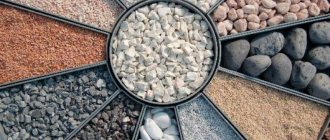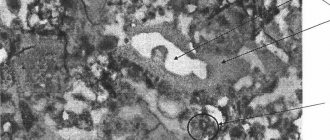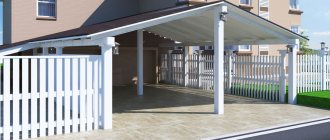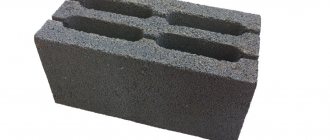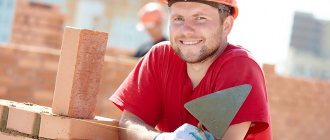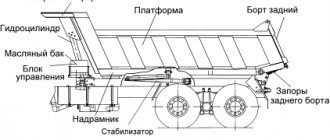Formula for calculation
In order to calculate how many blocks there are in a block cube, you just need to use a special formula. It looks like this: V=xyz; x, y, z here are the length, width and height respectively. This formula is suitable for absolutely any of the materials listed above. As a rule, the sizes of both the materials and the cubes themselves are different. The more building material you need, the larger the cube itself. Of course, it will be more convenient to take, for example, 5 large cubes than 10 small ones.
How many gas blocks will fit in 1m3?
Porous concrete is available in various types and configurations. Partition products are used in construction. The amount of aerated concrete in 1 m3 depends on the parameters. In 1 cube of foam blocks measuring 600x50x250 mm, 133 pieces are placed, 600x125x250 mm - 96 pieces, 600x300x250 mm - 40. If the construction project will be carried out independently, then you need to calculate the need.
1 square requires 5 products. They are easy to process and can be easily installed when installing utility lines. Porous products are characterized by seismic resistance and strength.
When using foam concrete for construction, you need to calculate how many foam blocks are in a cube. The need is calculated by multiplying the building parameters provided for in the design documentation, minus the openings.
Gas silicate blocks
Let's say you took a building material - blocks of so-called gas silicate. It's also worth noting what they are. Gas silicate blocks are a building material with a high level of thermal insulation and a cellular structure. It is obtained by mixing lime, water and quartz sand, which has been ground in advance, then adding a little more cement. In addition, autoclaving is mandatory in the production of these blocks. If we compare them with aerated concrete blocks, it should be noted that aerated silicate blocks have greater strength and less shrinkage. The pores themselves in this cellular material are distributed strictly evenly, their size ranges from 1 to 3 mm in diameter. These blocks do not burn and do not transmit sound, which is why they have earned their popularity. And thanks to the air contained in the cells, they also have high thermal insulation. They are also very durable.
How to calculate the number of gas silicate blocks in a cube?
Let's say we are faced with the task of calculating how many gas silicate blocks are in a cube. There are several types of blocks, they differ, of course, in size. For example, let's take a block whose dimensions are 600, 250 and 500 (length, width and height, respectively). If you multiply these numbers, you get a result that is 75,000 cm3 (1m3 = 1,000,000 cm3).
Next, you should divide 1m3 by the resulting volume of the cube presented, we get the result - 13, 33... Therefore, in one m3 there are 13 blocks of gas silicate material. This is how we answered the question of how many gas silicate blocks are in a cube of this building material. Now purchasing gas silicate blocks is easier than ever, and you will no longer be afraid that you will not have enough of this material or, on the contrary, you will purchase too much.
How many aerated concrete blocks 600x300x200 are in a cube (1 m3): how to calculate correctly
Simple, rectangular aerated concrete block for interior walls operating without load
How many 600x300x200 aerated concrete blocks are there in a cube and how to correctly calculate the required amount of such building material to build a garage, a house, or simply make partitions (lintels) in a building. The measurement in cubic meters conventionally denotes building materials with internal dimensions of 1x1 m.
The size may differ from the accepted standard; another factor is important here - the product of width, height and length must be equal to one. The number of aerated concrete blocks in a cube will be influenced by the parameters of the walls.
The purpose of the structures, masonry of several meters, external walls or indoor work serve as determining milestones for calculations and purchase of aerated concrete blocks in the required quantities.
Ideal material for construction
There are no ideal inventions, especially in the field of construction and finishing materials. You can find fault with any object, even a pillar that stands and doesn’t bother anyone.
In order not to later regret your decision to use aerated concrete blocks in personal construction, you need to obtain information in advance about the advantages and disadvantages of this material. As psychologists advise, write down all the pros and cons on a piece of paper, analyze which one and make the right decision.
| Advantages | Flaws |
| Easy to saw and cut. It can be processed and can be made into blocks of different shapes. | A fragile material that requires proper foundation construction with minimal shrinkage. |
| Low thermal conductivity or good heat-saving performance. | High moisture absorption. Therefore, it is necessary to apply a primer to the walls before plastering. |
| According to SNiP II-12-77 standards, the noise insulation index in housing can be within acceptable limits from 41 to 60 dB, which corresponds to buildings made of aerated concrete. | Attaching massive objects to aerated concrete blocks is problematic. |
| Harmless to human health, because is tested for radioactivity in laboratory conditions and does not lose its properties over the years. | The durability of aerated concrete blocks has not been tested by time. |
| There is no mold or mildew in aerated concrete blocks; its environment is considered unfavorable for the life of bacteria. In such housing, additional antiseptic treatment is not required. | |
| The aerated concrete block can withstand the load of the floor slabs and its own weight. Following the standards established for construction work with aerated concrete blocks, there will be no problems with the structure. | |
| The frost resistance of aerated concrete is especially important in regions with a sharply continental climate. |
Attention: Exotic-looking buildings can be built from aerated concrete blocks. Other materials do not provide such opportunities.
Comparative table of thermal conductivity of building materials
Aerated concrete blocks can be used as load-bearing structures for buildings that serve as the basis for your own home or garage. The strength indicator, in the opinion of the owners, should be at the forefront, but what does this look like in practice?
Characteristics and classification by brand
Porous structure of aerated concrete blocks
The raw materials for the production of aerated concrete blocks are cement, quartz sand, lime, aluminum powder, and water. The mixed ingredients are poured into an autoclave, where a chemical reaction takes place under pressure. The result is a porous structure of the products.
Higher density, stronger block and more weight
- How much a cube of aerated concrete weighs can be determined by the density of the aerated concrete block.
- In the marking it is designated by the letter D, and the numbers indicate the numerical density.
Attention: Low density indicates a high percentage of air bubbles in the product
- A large accumulation of air inclusions increases the thermal conductivity of the stone, but reduces its strength.
- D300-D500 is a heat-insulating type of aerated concrete. The D400 gas block has a strength index that is 45% higher than that of D300, but the thermal conductivity is 30% lower. The price of aerated concrete block D400 600x300x200 is significantly less than its denser analogues. They are used when laying partitions in frame construction.
- D500-D900 is a structural and thermal insulation material used for the construction of load-bearing walls of houses and ventilated facades.
- D1000-D1200 structural aerated concrete blocks for the construction of walls. Some builders believe that such blocks do not require insulating materials. Experts have not yet come to a consensus, but the fact that the structure of such blocks is rising by leaps and bounds is indisputable.
Don’t overpay for extra cubic meters
Time to work, time to rest
Building a house outside the city from aerated concrete blocks will require accurate calculations of building materials. No one will count them individually; it is necessary to decide how many blocks are in a cube of aerated concrete, how many cubes are needed for complete construction. The building can be one or two storeys, so the calculations will be individual for each specific case.
Two-story house with openings for windows and doors
- How many aerated concrete blocks in a cube with standard dimensions 600x300x200 need to be purchased to build a not very large building? Mathematics is an exact science, but it allows for rounding.
Aerated concrete: the number of pieces in a cube will determine the dimensions of length, width, height
- For correct calculation, the following formula is used: (L x H - Spr) x 1.05 x B = V, where
- L – total length of all walls made of aerated concrete blocks, m;
- H – average height of aerated concrete walls, m;
- Spr – total area of door and window openings, m²;
- 1.05 – safety factor for trimming;
- B – block thickness, m;
- V – calculated volume, m³.
How many aerated concrete blocks are there in a cube, if the products have this configuration
The given formula is of a recommendatory nature.
Expanded clay concrete blocks
For many, the choice of material for building a house falls on expanded clay concrete blocks. It is worth noting that such a building material is no less popular than gas silicate blocks. This material is made from an environmentally friendly product, the so-called expanded clay concrete, which is light and porous. It is obtained by firing exclusively natural clay.
This material is durable and very practical, since the expanded clay granule has a fairly strong shell. The blocks are ideal not only for the construction of a country house, but also for modern city buildings. In addition, they are used for the restoration of any old buildings, which after restoration become more durable. These blocks have a lot of unique properties: they do not burn, do not sink, do not rot, do not rust and do not react to sudden temperature changes. They also have good thermal insulation and sound insulation. They weigh relatively little. An important property of this material is moisture resistance.
Calculation of expanded clay concrete blocks in a cube
Calculating how many blocks are in a block cube is just as easy as in the first case. The calculation is usually made using the same formula. Therefore, when calculating, you can safely use the above example. Having performed just two steps, you will no longer doubt the amount of material purchased, therefore, having calculated how many expanded clay concrete blocks are in a cube, you can safely make their purchase. An interesting fact is that expanded clay concrete is a serious competitor to lightweight concrete, since these blocks help save both time and money. In addition, expanded clay concrete blocks are not inferior even to brick. After all, they are much lighter and more environmentally friendly, as well as more economical, which is extremely important for many owners of private houses.
How many aerated concrete blocks in 1m3: calculation
Storage of aerated concrete blocks
In order not to overpay for transportation costs or to avoid downtime during construction work, you need to know exactly how many aerated concrete blocks are in 1m3. Calculating such wall material is not so difficult. We take the project and “dive” with it into the abyss of numbers and geometric formulas.
Parameters of gas blocks
To find out how many pieces of aerated concrete are in 1m3, you need to accurately navigate the range of similar wall products. According to GOST 31360-2007 “Non-reinforced wall products made of autoclaved cellular concrete”, such building elements are produced in two types - these are blocks and slabs with the maximum permissible dimensions indicated in the table below.
| Size name | Dimensions, mm | |
| Block | Plate | |
| Length | 625 | 1500 |
| Width | 500 | 1000 |
| Height | 500 | — |
| Thickness | — | 600 |
According to this regulatory document, the production of not only solid products is allowed. They may contain voids and technical holes, the parameters of which must meet the requirements of this standard.
Blocks can also be produced with locking elements of various modifications. The latter ensure a more reliable fit of the blocks in the masonry. However, the price of products does not depend on this parameter.
Tongue-and-groove aerated concrete block
But these are not all the standard sizes that are present on the wall materials market today. The standard also allows for the production of gas blocks of other parameters at the request of customers, in principle, which manufacturers successfully use.
The tables below show the most common sizes of wall blocks. They allow you to use products of light weight, sufficient for comfortable reproduction of masonry with your own hands, while saving mortar due to their volume, and are also mobile enough for transportation both in pallets and individually in the trunk.
Attention! The construction project will help you determine the size of the blocks. All characteristics of building wall materials are described in detail there. In the absence of one, use the standard product parameters - 600 mm * 200 mm * 400 mm. Blocks with a thickness of no more than 100 mm are relevant for installing interior partitions.
Calculation of aerated concrete blocks
Storage of aerated concrete blocks
When calculating the economic part of construction, as well as to solve logistics issues, it is necessary to know the exact amount of material purchased.
A simple instruction will help you understand the basic calculations for gas blocks:
- How many m3 of aerated concrete block does its volume occupy? This entirely depends on its parameters. Let's consider the most popular sizes 60*20*40 cm. The volume of one product is calculated quite simply - all sides are multiplied and the value is converted into meters. For example: 0.6*0.2*0.4 = 0.048m3.
- The number of blocks in one cubic meter can be calculated by knowing the previous figure, namely: 1m3 / 0.048m3 = 20.83 pcs. But no seller will sell us too much, so we estimate approximately that there are 20 pieces in one cube. However, when recalculating for large volumes, we take the true figure.
Blocks of various parameters
- To purchase products for interior walls, you need to know how much aerated concrete is in a square meter. The calculation principle is the same as in the first case. Only when multiplying the parameters, the thickness of the blocks is not taken into account, since it is important to cover the required area, and not create the volume of the walls. Accordingly, the calculations will look like this: 0.6 * 0.2 = 0.12 m2. With this action we calculated the quadrature of one block. In order to know exactly how much aerated concrete is needed per square, we perform the following action: 1m2/0.12m2 = 8.33 pcs.
- How many aerated concrete blocks are on a pallet? There are no standards for laying a certain volume of aerated concrete blocks. It all depends on the standards adopted by the enterprise. But, usually, they try to fit 1 square meter of small-piece wall products on a pallet.
Automatic stacking of blocks on pallets
Knowing the unit volumes of blocks, it becomes possible to accurately calculate their total quantity for building a house. To do this, calculate the total square footage of load-bearing walls by multiplying their height by the total perimeter minus all door and window openings.
If the project requires load-bearing walls to be erected in two blocks, then, accordingly, this value doubles.
Attention! When purchasing wall products, regardless of their quality, they always take a small reserve for trimming and scrap of about 2-3 squares.
This article will tell you in more detail how to calculate volumes, taking into account all the geometric subtleties of the project.
Transportation and storage of aerated concrete
The photo shows how much aerated concrete can fit in a pallet
Knowing how many aerated concrete blocks are in a pallet, you can easily calculate the total volume and number of trips required to transport the entire number of products. For such calculations, it is also necessary to take into account the carrying capacity and area of the transport used.
What else you need to know when working with gas blocks:
- It is highly not recommended to transport products unpacked or loosely packed, especially over long distances and along country roads. If blocks fall, there is a risk of them breaking.
- When purchasing aerated concrete, you need to provide them with a high-quality storage area. After all, such a material is susceptible to moisture and may begin to deteriorate over time.
- It is recommended to place pallets on a flat asphalt area away from the formation of puddles and slush.
- If the manufacturer did not provide for packing a pallet of blocks entirely in polyethylene, then it is advisable to place the aerated concrete under a canopy, especially if long-term seasonal storage is expected.
A little tip! When unpacking pallets, do not throw away the markings! It may be useful as evidence of the purchase of low-quality products if similar problems arise in the future.
Also, to open such a dispute, you must have quality certificates for each purchased batch. This is the only way to return as many products as 1m3 of aerated concrete blocks turned out to be of poor quality.
Source: https://beton-house.com/stroitelstvo/iz-gazobetona/kladka/skolko-gazobetonnyh-blokov-v-1m3-146
Aerated concrete blocks
As for aerated concrete blocks, it is worth noting that this is a fairly common type of material for construction.
and blocks are artificial stone with a porous structure. To produce this material, water, quartz sand, lime, cement and aluminum powder are used. Aerated concrete belongs to the class of cellular building materials. Its production technology is constantly being improved, and aerated concrete dates back to 1889. An interesting fact is that the properties of aerated concrete blocks depend on the method of formation of pores in them and their placement. The very conditions for the production of this material are different, therefore, the blocks themselves are different in weight, pore location, etc.
Density
This indicator is proportional to the grade of concrete. Each type of building element is used to lay structures with different loads. In order not to make a mistake when choosing a brand, you should familiarize yourself with their purpose. Aerated concrete D600 is characterized by high strength.
Monoliths are erected from D500 blocks, D 400 - for arranging insulation when installing openings. Products made from aerated concrete D350, which has high porosity and a loose structure, are used primarily for heat insulation.
The material absorbs moisture, so a moisture-insulating soil ball is applied to the walls. The block manufacturing technology involves mixing the ingredients, which, when interacting, form a porous structure. High-density building elements have more weight.
How much aerated concrete in a cube can be determined by the density of the block. This indicator is designated D, and the numbers after the letter marking indicate the density value. A low index value corresponds to the presence of a large number of air pores, which increase heat conductivity.
The strength index of the D400 gas block is 45% higher than that of D300, but the thermal conductivity is 30% lower. The price of building products of the D400, 200, 300, 600 cm brand in Moscow and other regions is lower than for similar products of higher density.
Currently reading: Types and classification of lightweight concrete
How to calculate the number of aerated concrete blocks in a cube?
In order to calculate how many blocks in a cube of blocks specifically for aerated concrete material, you should use the same formula. And after this calculation, you can start purchasing this material. If you correctly calculate how many blocks are in a cube of aerated concrete, then there should be enough material for the intended construction. Of course, there is nothing difficult in the calculations, but you still need to do them very carefully, because even the smallest mistake can lead to a shortage of blocks or an excess of them.
Prices, of course, are different for all these types of building materials. Let's say you chose aerated concrete blocks to build a house. The price per cube can vary from 3200 to 3800 Russian rubles.
As a result, we can say that the most important action in the construction of any project is to correctly calculate how many blocks are in a cube of blocks. But you shouldn’t rush, you need to thoroughly study several sites with the proposed material, compare their prices and make sure of the quality of the material itself. And when you have already calculated how many blocks are in 1 cube, and have studied the entire range offered, you can safely start purchasing the material. It should also be remembered that you cannot save too much on construction, as this can lead to rapid destruction of the house or to some of its defects. It is worth paying a lot of attention to the manufacturing company itself, as well as reading reviews about its products. And, of course, the service life of the house will also depend on how correctly the construction itself was carried out, because failure cannot be blamed only on the material. You can even build a house from the highest quality materials that won’t last even a month.
How many aerated concrete blocks are in 1m3 (calculation example)
If you need to calculate how many gas blocks are in one cube, you need to perform two steps. First of all, you should measure the parameters of one gas block and determine the volume of the product in cubic meters. After this, the unit must be divided by the number obtained earlier. For example, if the parameters are 300 by 250 by 625 millimeters, then to calculate the volume of one gas block, it is necessary to calculate the product of all sides of the product in meters. It turns out: 0.3*0.25*0.6 = 0.04 cubic meters. Then we divide one cubic meter by the volume of the gas block: 1:0.04 = 21.3...pieces. Thus, there are 21 gas blocks in one cube.
To determine the dimensions of aerated concrete products, you can go to the websites of their manufacturers - there you can find tables that indicate all the values. Having found out exactly how many pieces of gas blocks there are in one cubic meter, you can begin to calculate the amount of building material for construction. It all depends on the parameters of the future structure. To make the necessary calculations of the material, in addition to its quantity, it is important to take into account the weight. Thus, knowing the number of gas blocks and the weight of one cubic meter of material, you can calculate the total mass.
Return to contents
Calculation of the volume of foam blocks
The foam block parameters are indicated in the proportion: width x height x length
Foam block 200x200x400
Volume: 0.016 cubic meters
Quantity per cube: 62.5 pieces
Foam block 200x300x400
Foam block volume: 0.024 cubic meters.
Quantity per cube: 41.7 pieces
Foam block 100x300x600
Foam block volume: 0.018 cubic meters.
Quantity per cube: 55.6 pieces
Foam block 125x300x600
Foam block volume: 0.023 cubic meters.
Quantity per cube: 43.5 pieces
Foam block 150x300x600
Foam block volume: 0.027 cubic meters.
Quantity per cube: 37 pieces
Foam block 200x300x600
Foam block volume: 0.036 cubic meters.
Quantity per cube: 27, 7 pieces
Foam block 250x300x600
Foam block volume: 0.045 cubic meters.
Quantity per cube: 22, 2 pieces
Foam block 300x300x600
Foam block volume: 0.054 cubic meters.
Quantity per cube: 18.5 pieces
Foam block 200x400x600
Foam block volume: 0.048 cubic meters.
Quantity per cube: 20, 8 pieces
Foam block 300x400x600
Foam block volume: 0.072 cubic meters.
Quantity per cube: 13, 8 pieces
How many foam blocks do you need per house?
Today, to help developers, we will calculate how many 200x300x600 to build a house, for example, 10x10 m in size, excluding window and door openings. When we get the exact figure, we can subtract from it the cubic capacity that the frames and door structures will occupy. And then we’ll convert the actual number of blocks into volume and find out how many foam blocks fit in m3.
In principle, all foam blocks are produced in accordance with the conditions of profile GOSTs, which require standard dimensions of building materials.
The cubic capacity of the four walls depends on how thick the main wall will be. If the developer decided to build a wall of foam blocks, laying them flat, then more cubic meters will be required.
Arrangement of foam blocks flat
We multiply the length of the entire perimeter of the house 40 m by 0.3 m and the height of the house by 3 m. The result is 36 m³. The total is 997, 2 foam blocks for such a structure.
Arrangement of foam blocks vertically
Now let’s calculate how many cubes are needed if we place the block in the wall with the smaller side. We multiply 40 m of perimeter by 0.2 m and by the height of the house of 3 m. As a result, we get 24 m³ - that’s 664.8 foam blocks. Just because the thickness of the wall was increased, 12 m³ more blocks were required. This is as much as 332.4 blocks.
Results
Accurate calculation of consumable building materials saves a lot of personal money. If housing is being built in warm regions, then the developer will receive large cost savings only on masonry.
We calculate how many foam blocks are in a cube
Typically, such information can be clarified by consulting the manufacturer. Most plant managers will provide all the necessary information upon request.
It can be presented in the following form:
- Cost per 1m³, rub.
- Size of one foam block, (LxWxH), mm.
- Volume of one foam block, m³.
- Weight of one foam block depending on density, kg.
- Size of pallet with foam blocks, (LxWxH) mm.
- Quantity on one pallet, pieces and m³.
- Weight of a pallet with foam blocks depending on density, kg.
- Logistics data (number of pallets in one machine).
Foam block with dimensions 600 x 300 x 200 (meaning: length 600; width 300; height 200) is most often used for the construction of load-bearing walls of buildings. It is quite large and comfortable, and its width of 300 mm is already enough to build a one-story house with an attic.
If it is not possible to contact the supplier before ordering or there is no desire to do so, then 200x300x600 blocks, like any other material, can be calculated yourself.
- Let's convert the dimensions of the blocks from mm to m (200 mm = 0.2 m; 300 mm = 0.3 m; 600 mm = 0.6 m).
- Let's determine the volume of one block - Vblock = Length x Width x Height = 0.6 x 0.3 x 0.2 = 0.036 m³.
- We get the number of blocks in one cubic meter - 1m³/Vblock=1/0.036=27.78 pcs.
To avoid calculating the number of blocks, use the table below.
Table of block dimensions and their volume
| Size | Volume of one block | Quantity per pallet | Quantity per 1m³ | |
| (LxWxH), mm | m³ | PC | m³ | PC |
| 600x50x250 | 0,0075 | 192 | 1,44 | 133,3 |
| 600x75x250 | 0,01125 | 160 | 1,8 | 88,9 |
| 600x80x250 | 0,012 | 144 | 1,728 | 83,3 |
| 600x100x250 | 0,015 | 120 | 1,8 | 66,7 |
| 600x125x250 | 0,01875 | 96 | 1,8 | 53,3 |
| 600x150x250 | 0,0225 | 80 | 1,8 | 44,4 |
| 600x200x250 | 0,03 | 64 | 1,92 | 33,3 |
| 600x300x200 | 0,036 | 50 | 1,8 | 27,8 |
| 600x250x250 | 0,0375 | 48 | 1,8 | 26,7 |
| 600x300x250 | 0,045 | 40 | 1,8 | 22,2 |
| 600x350x250 | 0,0525 | 32 | 1,62 | 17,8 |
| 600x375x250 | 0,05625 | 32 | 1,8 | 17,8 |
| 600x400x250 | 0,06 | 32 | 1,92 | 16,7 |
| 600x500x250 | 0,075 | 24 | 1,8 | 13,3 |

